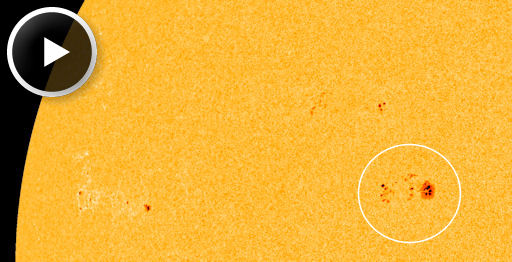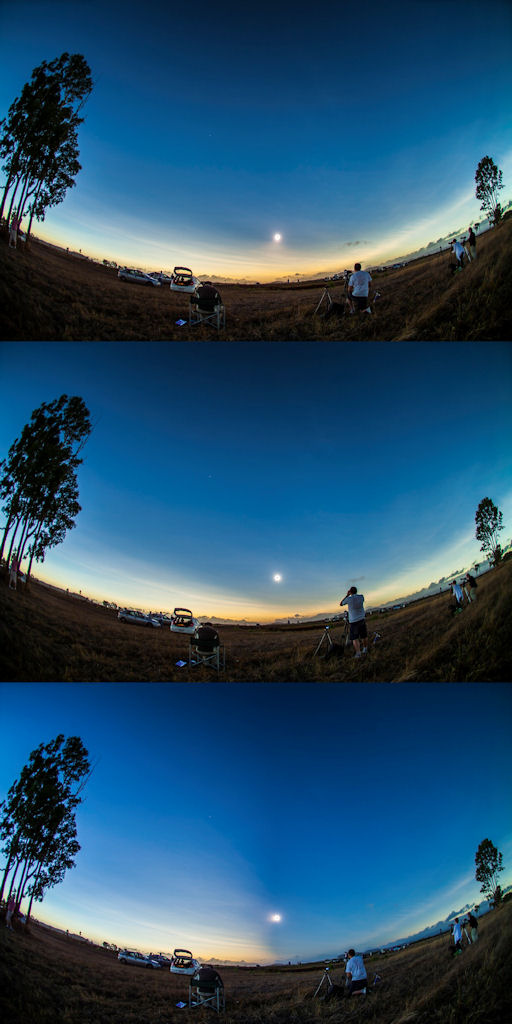MILD LEONIDS: The Leonid meteor shower peaks on Nov. 17/18 as Earth passes through a stream of debris from Comet Tempel-Tuttle. Reports so far are consistent with a weak shower--no more than about 10 per hour. In the past, Leonids have been known to produce fantastic storms of thousands of shooting stars. This year, however, Earth is passing through the outskirts of the comet's debris stream, so the shower is relatively mild. [meteor gallery] [meteor radar]
FAST-GROWING SUNSPOT: Barely visible when the weekend began, sunspot AR1619 has blossomed into a large active region more than three times as wide as Earth. Click to play a 24 hour movie recorded by NASA's Solar and Heliospheric Observatory:
So far the growing sunspot has not produced any significant flares, but the quiet is unlikely to continue if its expansion continues apace. Fast-changing magnetic fields on the sun have a tendency to reconnect and erupt. NOAA forecasters estimate a 20% chance of M-class solar flares during the next 24 hours.Solar flare alerts: text, voice.
Realtime Space Weather Photo Gallery
INSIDE THE SHADOW OF THE MOON: On Nov. 13/14, the Moon passed directly i front of the sun. This arrangement, which produced a total eclipse, cast the shadow of the Moon directly down on northeast Australia. Using a wide-field camera, eclipse-chaser Alan Dyer photographed the shadow as it raced across the sky over Lakeland Downs, Queensland. Scan the images, then read Dyer's account of the shadow-transit below:
"This collage of wide-angle shots shows the motion of the Moon's conical shadow," he explains. "At top, you can see the bottom edge of the shadow just touching the Sun. This was second contact and the diamond ring effect that begins totality. The middle frame was taken near mid-eclipse and shows the bright horizon beyond the Moons shadow. However, the Sun is not centered on the shadow because we were located well north of the eclipse's center-line, where we had gone to escape nearby clouds. The bottom frame was taken at the end of totality as the first bit of sunlight bursts out from behind the Moon. Notice the sun sitting at the well-defined left edge of the Moon's shadow. The shadow moved off to the right."
People who have experienced total eclipses first-hand say the Moon's shadow is one of the most amazing aspects of the experience. Its arrival causes many birds to stop singing; a hush descends on the landscape as the sky darkens and the air temperature suddenly drops. The Moon's shadow lances more than a quarter million miles across the silent vacuum of space, and when it lands on Earth, it seems to bring a bit of otherworldly cold with it.
For more otherworldly images of the eclipse, browse the gallery:

![]()
Solar wind
speed: 386.9 km/sec
density: 1.6 protons/cm3
explanation | more data
Updated: Today at 2117 UT
![]()
X-ray Solar Flares
6-hr max: C1 1532 UT Nov18
24-hr: C5 0407 UT Nov18
explanation | more data
Updated: Today at: 2100 UT
![]()
![]()
![]()
Daily Sun: 18 Nov 12
![]()
![]()
New sunspot AR1619 poses a threat for M-class solar flares. Credit: SDO/HMI
![]()
![]()
![]()
Sunspot number: 163
What is the sunspot number?
Updated 18 Nov 2012
Spotless Days
Current Stretch: 0 days
2012 total: 0 days (0%)
2011 total: 2 days (<1%)
2010 total: 51 days (14%)
2009 total: 260 days (71%)
Since 2004: 821 days
Typical Solar Min: 486 days
Update 18 Nov 2012
The Radio Sun
10.7 cm flux: 135 sfu
explanation | more data
Updated 18 Nov 2012
![]()
![]()
![]()
Current Auroral Oval:
![]()
Switch to: Europe, USA, New Zealand, Antarctica
Credit: NOAA/POES
![]()
![]()
![]()
Planetary K-index
Now: Kp= 0 quiet
24-hr max: Kp= 2 quiet
explanation | more data
![]()
Interplanetary Mag. Field
Btotal: 5.1 nT
Bz: 2.1 nT south
explanation | more data
Updated: Today at 2116 UT
![]()
![]()
![]()
Coronal Holes: 18 Nov 12
![]()
![]()
There are no large coronal holes on the Earthside of the sun. Credit: SDO/AIA.






